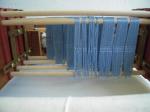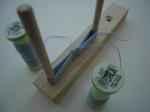I first wanted to undertake this study of “brocade” weaving after encountering it as a kind of cheating in the weaving of twill-tapestry Kashmir shawls: instead of having a dedicated weft at every colour-change along the pick where one is needed, one weft may skip to several nearby places where the same colour is required, in order to keep down the number of weft bobbins in play. Because this tactic needs to be repeated in every pick, floats quickly build up and can distort the fabric, so it’s a bad practice, but nevertheless dignified by the name “spot brocade”, according to my mentor Grace Beardsley.
“Brocade” is a word like “tapestry” that many people know a little about what it looks like, but not about how it’s made. Brocade starts off being a loom-woven fabric of a uniform appearance, then the regular repetition of the weave structure is interrupted by the representation of a visual design, using additional wefts that accompany or replace the background weft, to appear on the front where they are needed. These additional wefts may run from selvedge to selvedge by shuttle, or may be inserted in places by hand using bobbins. Because they are only displayed part of the time on the front, masses of floats can accumulate on the back of the fabric, that need to be contained in some way to prevent snagging, or cut away.
I have the benefit of Rahul Jain’s documentation of patkas in the collection of the Calico Museum (Jain, Rahul. “Mughal Patkas, Ashavali Saris, and Indo-Iranian Metal-ground Fragments in the Collections of the Calico Museum of Textiles and the Sarabhai Foundation”, Ahmedabad, India, 2008), that I acquired by mistake, hoping twill-tapestry technique would be included. Patkas and Kashmir long shawls share the same boxes-within-boxes format of field, featured end-panels, and side- and cross-borders, and the same prompting from their Mughal patrons to show off their most intricate work and to portray their favourite flowers. But while twill-tapestry relies on step-by-step, pick-by-pick instructions and complex hand manipulations, other types of patka weaving use the individual warp thread lifts of the drawloom – or jacquard, for that matter – to combine weave structure and pattern information for the passage of each shuttle or bobbin.

I became fascinated with what Rahul Jain categorized as a Type 1 patka which displayed the simple logic of a complex process: a double-cloth structure where two layers are woven-up simultaneously, and patterning results from swapping the front weft with a contrasting weft from the back layer. Being a relatively inexperienced loom-weaver, it was reassuring that the weave structures of the individual layers were simple and familiar – the front, 1/3 twill, for the predominance of pattern wefts in the front view; and the back, plain weave, providing some stiffening and a tidy back view.

For this small sample, I knew that I could improvise a shed-changing arrangement on a portable frame loom, but I did not have anything that would serve as a drawloom harness to lift individual warps. I needed 4 shafts for the 1/3 twill and 2 shafts for the plain weave, provided by catching each warp in a continuous looping of thread around each dowel – a “lifting” shaft where the warps are only held in order by warp-tension and previous treadlings. No reed – just a tapestryweaver’s comb for a beater. I placed the 2 shafts for the plainweave layer at the front of the harness, hoping to make it easier to get a clear shed with so many warps switching places.
Instead of lifted warps presenting a ready-made shed for each pattern weft, I expected to hand-pick my pattern in digital increments using the one-in-four raised warps of each 1/3 twill treadling as my grid-lines. An early and long-unanswered question was whether the weaving proceeds front or back side up – apparently the correct answer is back side up. (That doesn’t explain why the twill grain rises to the right on the front, while in Kashmir shawl weaving from the back, the twill grain always ends up rising to the left on the front.) I realised hand-picking pattern accurately would require constant hair-splitting, and decided to work from the front – no need to stand on my head as well, to do it. But I discovered how helpful it was to flip the frame loom over to tease out the shed of the back layer.
The typical patka is woven of fine silk threads, for a multitude of functional as well as decorative reasons. Nevertheless, I worked with wool threads, 1/8 singles, at hand in a wide range of colours. I had some experience weaving with them at about 20 threads to the inch, so I thought: front layer…back layer…they don’t have to pass through each other, they just occasionally get stitched together…make the sett 40 threads to the inch. I didn’t reckon on the two sets of warps having to slip by each other to raise a shed. I should have started over and relaxed the sett, but I persisted and struggled with it weaving up too fast, elongating the pattern of a motif meant to be circular. I switched to some very fine merino knitting yarns for my substituting and supplementary pattern wefts, that reduced the take-up slightly in the plain-weave layer.
Once I had established a heading, I wove up the two layers separately in an alternation of single or double picks. A 1/3 twill treadling of the front layer presents easily, face up on the loom. Then, to switch to the corresponding back-layer treadling, I secure all loose ends, flip the frame over, and tease out the shed.

To weave picks that include pattern, I first pick the path of the front layer background weft – it travels from selvedge to selvedge most of the way visible under the single 1/3 twill tie-down warps, but occasionally dips down through the web to form a float under everything when it’s displaced by a pattern weft. The front-layer background weft often features zari thread for an extravagant cloth-of-gold effect – not only shows off to the max but helps to preserve the fragile metal-wrapped thread with minimal turn-backs and deflections from its straight path.
Starting with the appropriate 1/3 treadling, I put a strip of card stock in to retain the shed. I use a pointed shedding-stick to collect the segments of the shed that the weft will travel, alternately under the tie-down warps, and under all warps. I use a bodkin to select the places where the weft will dip down and return. When I have the complete pick collected on the shedding stick, I can remove the card, open the shed and pass the weft shuttle.


Next, I need to pick the path of the back-layer weft, which travels selvedge to selvedge in the plain-weave shed of the back layer, occasionally appearing as pattern weft on the front. I treadle the back layer shed, flip the frame over, patiently clear the shed, and put a strip of card stock in to retain it. Then again from the front, I treadle the same 1/3 treadling as before, and retain it with another strip of card stock. I use the shedding stick and bodkin to alternate between under all the warps that are lying over the back-shed strip of cardboard, and under only the front tie-down warps. When I have the complete pick collected on the shedding stick, I can remove both cards, open the shed and pass the weft shuttle.
In portions of the pick to be filled by additional (“discontinuous”) wefts not part of the back layer, the front background weft shifts to float on the back, but the back-layer weft stays in its shed unless it is part of the patterning. In theory all occurrances of the same colour weft in the pick would be woven at once by shuttle; in practice I insert colours in succession to cross an area of patterning such as the leaf or flower petals. Only one bobbin of each colour may be enough to span a motif, but another one strategically placed may help to reduce floats. Interlocking is not required – by the next pick the additional wefts are anchored by – and helping to tie-down – the intervening background weft floating across the back.
Where am I getting, and how am I applying, my design instructions? Fortunately I had previously worked out a draft of the floral sprig, in a digital format based on counting units in each row from side to side. These correspond to “weave-units” of the 1/3 twill, which are marked by the tie-down warps of the current treadling. The weave unit of 1/3 twill includes 4 warps and 4 picks, and is essentially square in aspect-ratio – each row of a design on a square grid would be woven the same in 4 picks. In the design I am using on a brick grid, each pick is woven the same twice, and the placement of the next row of grid units represents the shift of the stitches of weft, 2 treadlings later.
I discovered these correspondences because of my experience with Kashmir shawl weaving, all due to the 4 by 4 size of the weave unit and the straight twill progression in the treadling, whether it’s under-two-over-two or under-one-over-three. Working in 4’s is made-to-order for the 4-shaft counterbalance harness, ubiquitous in Kashmir and wherever 4 shafts is enough. Fours also have a close working relationship with 2’s and the reciprocal movement of left-to-right and right to left. For all warps to be attached to one of only four groups allows little scope to produce brocade imagery, thus the need for handwork and detailed instructions. On the other hand the drawloom or jacquard with its individual warp lifts is just giving the appearance of twill weave – it could be any structure that facilitates the substitution of coloured wefts.

I found the work routine tedious and fussy in ways less rewarding than twill-tapestry shawlweaving, where wefts connect in sequence and counting errors give themselves away at the end of the pick. This brocade weaving with the pattern hand-picked, requires selecting an opening at each point the weft appears and disappears, and has a way of revealing mistakes further back than I want to go, to correct them. At best it’s a process of multiple steps to accomplish each complete pick.
In that spirit I wondered if the front-layer background weft could be woven into the back layer when it’s displaced by patterning, instead of left to float freely on the back. It just requires the same combination of treadlings as for the back-layer weft used for patterning, producing something even more like a true double-cloth.
It would seem possible to make creative use of this method of hand-picking pattern, from a pictorial design or from an image firmly in mind, as in tapestryweaving. Because the back layer weft is always present as a potential pattern weft, there’s no worry about needing to introduce additional bobbins to represent awkwardly placed details. A brocade design of only two colours can be infinitely detailed but composed of only two weft threads. Conversely, a tapestry design can be only two colours and still require an additional weft at every colour-change along the pick.
By weaving a sample, I wanted not only to see if this alternation of pattern and background wefts worked, but to inhabit the structure, lay out the path for the weft to follow… The shed that stands propped open one moment, is closed and locked by the next pick… Fabric is composed more of structure than of substance.
























































